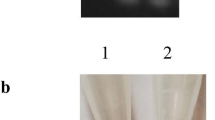Abstract
A rapid detection method for Enterohemorrhagic Escherichia coli (EHEC), which has the virulent stx2 gene, was developed using a two-step, ultra-rapid real-time (URRT) PCR. URRT PCR was designed to detect the stx2 gene using a microchip-based, real-time PCR system, GenSpector TMC-1000, which only has a 6 μl total reaction volume with an extremely short denaturation step and combined annealing/extension step (1 and 3 s, respectively) for each cycle. Specific primers for the stx2 gene were designed to amplify a 100 bp region known for genetic stability among the various EHEC strains. Using the URRT PCR method, stx2 gene could be detected in 7 min 8 s including melting point (Tm) analysis. The detection limit for the stx2 gene for URRT-PCR was estimated to be 3 c.f.u./PCR with the amplification product having a consistent Tm of 85.2 ± 0.4°C. This method was tested for the various applications relevant to the different EHEC strains and was useful for the rapid detection of stx2-carrying EHEC strains.






Similar content being viewed by others
References
Bellin T, Pulz M, Matussek A, Hempen HG, Gunzer F (2001) Rapid detection of enterohemorrhagic Escherichia coli by real-time PCR with fluorescent hybridization probes. J Clin Microbiol 39:370–374
Beutin L, Miko A, Krause G, Pries K, Haby S, Steege K, Albrecht N (2007) Identification of human-pathogenic strains of Shiga toxin-producing Escherichia coli from food by a combination of serotyping and molecular typing of Shiga toxin genes. Appl Environ Microbiol 73:4769–4775
Blanco JE, Blanco M, Alonso MP, Mora A, Dahbi G, Coira MA, Blanco J (2004) Serotypes, virulence genes, and intimin types of Shiga toxin (verotoxin)-producing Escherichia coli isolates from human patients: prevalence in Lugo, Spain, from 1992 through 1999. J Clin Microbiol 42:311–319
Boerlin P, McEwen SA, Boerlin-Petzold F, Wilson JB, Johnson RP, Gyles CL (1999) Associations between virulence factors of Shiga toxin-producing Escherichia coli and disease in humans. J Clin Microbiol 37:497–503
Caprioli A, Morabito S, Brugère H, Oswald E (2005) Enterohaemorrhagic Escherichia coli: emerging issues on virulence and modes of transmission. Vet Res 36:289–311
Cho YK, Kim J, Lee Y, Kim YA, Namkoong K, Lim H, Oh KW, Kim S, Han J, Park C, Pak YE, Ki CS, Choi JR, Myeong HK, Ko C (2006) Clinical evaluation of micro-scale chip-based PCR system for rapid detection of hepatitis B virus. Biosens Bioelectron 21:2161–2169
Friedrich AW, Bielaszewska M, Zhang WL, Pulz M, Kuczius T, Ammon A, Karch H (2002) Escherichia coli harboring Shiga toxin 2 gene variants: frequency and association with Clinical symptoms. J Infect Dis 185:74–84
Han SH, Lee DB, Lee DW, Kim EH, Yoon BS (2008) Ultra-rapid real-time PCR for the detection of Paenibacillus larvae, the causative agent of American Foulbrood (AFB). J Invertebr Pathol 99:8–13
Kehl SC (2002) Role of the laboratory in the diagnosis of enterohemorrhagic Escherichia coli infections. J Clin Microbiol 40:2711–2715
Kim HH, Kang YH, Kim SH, Park MS, Yu JY, Chun JH, Richard AW, Lee BK (1998) Studies on the agglutinin-specificity of the rabbit serogroup antisera which were immunized with enterohaemorrhagic E. coli (EHEC) serogroup O25, O26, O55, O103, O104, O111, O145 and O157 antigens. J Korean Soc Microbiol 33:499–505
Kim EH, Lee DW, Han SH, Lim YK, Yoon BS (2007) Development of Ultra-rapid multiplex real-time PCR for the detection of genes from avian influenza virus subtype H5N1. Korean J Vet Res 47:399–407
Klein EJ, Stapp JR, Neill MA, Besser JM, Osterholm MT, Tarr PI (2004) Shiga toxin antigen detection should not replace sorbitol MacConkey agar screening of stool specimens. J Clin Microbiol 42:4416–4417
Lee DW, Kim EH, Yoo MS, Kim IW, Yoon BS (2007) Ultra-rapid two step real-time PCR for the detection of human immunodeficiency virus (HIV). Korean J Microbiol 43:264–272
March SB, Ratnam S (1986) Sorbitol-MacConkey medium for detection of Escherichia coli O157:H7 associated with hemorrhagic colitis. J Clin Microbiol 23:869–872
Nataro JP, Kaper JB (1998) Diarrheagenic Escherichia coli. Clin Microbiol Rev 11:142–201
Paton JC, Paton AW (1998) Pathogenesis and diagnosis of Shiga toxin-producing Escherichia coli infections. Clin Microbiol Rev 11:450–479
Perera LP, Marques LR, O’Brien AD (1988) Isolation and characterization of monoclonal antibodies to Shiga-like toxin II of enterohemorrhagic Escherichia coli and use of the monoclonal antibodies in a colony enzyme-linked immunosorbent assay. J Clin Microbiol 26:2127–2131
Schuurman T, Roovers A, van der Zwaluw WK, van Zwet AA, Sabbe LJ, Kooistra-Smid AM, van Duynhoven YT (2007) Evaluation of 5′-nuclease and hybridization probe assays for the detection of shiga toxin-producing Escherichia coli in human stools. J Microbiol Methods 70:406–415
Sharma VK, Dean-Nystrom EA (2003) Detection of enterohemorrhagic Escherichia coli O157:H7 by using a multiplex real-time PCR assay for genes encoding intimin and Shiga toxins. Vet Microbiol 93:247–260
Teel LD, Daly JA, Jerris RC, Maul D, Svanas G, O’Brien AD, Park CH (2007) Rapid detection of Shiga toxin-producing Escherichia coli by optical immunoassay. J Clin Microbiol 45:3377–3380
Verweyen HM, Karch H, Brandis M, Zimmerhackl LB (2000) Enterohemorrhagic Escherichia coli infections: following transmission routes. Pediatr Nephrol 14:73–83
Yamazaki M, Sato S, Gondaira F, Sugiyama J (2001) A rapid bioluminescent enzyme immunoassay (BLEIA) for the detection of Shiga toxin types 1 and 2. Microbiol Immunol 45:621–628
Author information
Authors and Affiliations
Corresponding authors
Rights and permissions
About this article
Cite this article
Kim, IW., Kang, MH., Kwon, SH. et al. Rapid detection of virulence stx2 gene of Enterohemorrhagic Escherichia coli using two-step ultra-rapid real-time PCR. Biotechnol Lett 32, 681–688 (2010). https://doi.org/10.1007/s10529-010-0205-0
Received:
Accepted:
Published:
Issue Date:
DOI: https://doi.org/10.1007/s10529-010-0205-0




